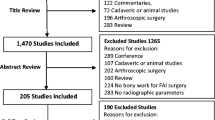Abstract
Introduction
In our institutional experience, determination of the alpha (α) angle at MR arthrography as an indicator of the likelihood of cam-type femoroacetabular impingement (FAI) is fraught with inconsistency. The aims of this study were to quantify the degree of variability in and calculate the diagnostic accuracy of the α angle in suggesting a diagnosis of cam impingement, to determine the accuracy of a positive clinical impingement test, and to suggest alternative MR arthrographic measures of femoral head–neck overgrowth and determine their diagnostic utilities.
Materials and methods
We carried out a retrospective analysis of MR arthrographic studies performed during a 4-year period, combined with chart analysis, which allowed identification of 78 patients in whom surgical correlation was also available. The status of a preoperative clinical impingement test was also noted. Patients were designated as having cam-type FAI (Group A, n = 39) if intra-operative femoral head–neck junction bony osteochondroplasty/arthoscopic femoral debridement was performed. Group B (n = 39) acted as controls. Three radiologists independently and blindly performed a series of measurements (α angle and two newly proposed measurements) in each patient on two separate occasions. An α angle of greater than 55° was considered indicative of the presence of cam-type FAI.
Results
Performance values for α angle measurement were poor for each observer. There was considerable (up to 30% of the mean value) intra-observer variability between the first and second α angle measurements for each subject. Binary logistic regression analysis confirmed that the α angle is of no value in predicting the presence or absence of cam-FAI. A statistically significant difference existed between Groups A and B with regard to the newly proposed anterior femoral distance (AFD; p = 0.004). Using an AFD value of 3.60 mm or greater as being indicative of the presence of cam-FAI yields a 0.67 performance measure (95% confidence interval 0.55–0.79). The second proposed parameter (femoral neck ratio) was of no value in suggesting the presence or absence of this condition. The sensitivity, specificity, and positive and negative predictive values of the clinical impingement test were 76.9%, 87.2%, 85.7% and 79.1% respectively.
Conclusions
Femoral α angle measurement is associated with considerable variability. This index performed poorly in our patient population and was statistically of no value in suggesting the presence or absence of cam-FAI. One of our proposed measures, the AFD, outperformed the α angle, though to an insufficient degree to suggest its routine incorporation into clinical practice. Our experience suggests that the clinical impingement test remains the most reliable predictor of the presence of this condition.






Similar content being viewed by others

References
Tanzer M, Noiseux N. Osseous abnormalities and early osteoarthritis. Clin Orthop Relat Res. 2004;429:170–7.
Jager M, Wild A, Westhoff B, Krauspe R. Femoroacetabular impingement caused by a femoral osseous head-neck bump deformity: clinical, radiological and experimental results. J Orthop Sci. 2004;9:256–63.
Ganz R, Parvizi J, Beck M, Leunig M, Nötzli H, Siebenrock KA. Femoroacetabular impingement: a cause for osteoarthritis of the hip. Clin Orthop Relat Res. 2003;417:1–9.
Tannast M, Siebenrock KA, Anderson SE. Femoroacetabular impingement: radiographic diagnosis—what the radiologist should know. AJR Am J Roentgenol. 2007;188(6):1540–52.
Beck M, Kalhor M, Leunig M, Ganz R. Hip morphology influences the pattern of damage to the acetabular cartilage: femoroacetabular impingement as a cause of early osteoarthritis of the hip. J Bone Joint Surg Br. 2005;87:1012–8.
Nötzli HP, Wyss TF, Stocklin CH, Schmid MR, Treiber K, Hodler J. The contour of the femoral head-neck junction as a predictor for the risk of anterior impingement. J Bone Joint Surg Br. 2002;84:556–60.
Kassarjian A, Yoon LS, Belzile E, Connolly SA, Millis MB, Palmer WE. Triad of MR arthrographic findings in patients with cam-type femoroacetabular impingement. Radiology. 2005;236(2):588–92.
Nouh MR, Schweitzer ME, Rybak L, Cohen J. Femoroacetabular impingement: can the alpha angle be estimated? AJR Am J Roentgenol. 2008;190:1260–2.
Beaule PE, Zaragoza E, Motamedi K, Copelan N, Dorey FJ. Three-dimensional computed tomography of the hip in the assessment of femoroacetabular impingement. J Orthop Res. 2005;23(6):1286–92.
Pfirrmann CW, Mengiardi B, Dora C, Kalberer F, Zanetti M, Hodler J. Cam and pincer femoroacetabular impingement: characteristic MR arthrographic findings in 50 patients. Radiology. 2006;240(3):778–85.
Author information
Authors and Affiliations
Corresponding author
Rights and permissions
About this article
Cite this article
Lohan, D.G., Seeger, L.L., Motamedi, K. et al. Cam-type femoral-acetabular impingement: is the alpha angle the best MR arthrography has to offer?. Skeletal Radiol 38, 855–862 (2009). https://doi.org/10.1007/s00256-009-0745-3
Received:
Revised:
Accepted:
Published:
Issue Date:
DOI: https://doi.org/10.1007/s00256-009-0745-3



